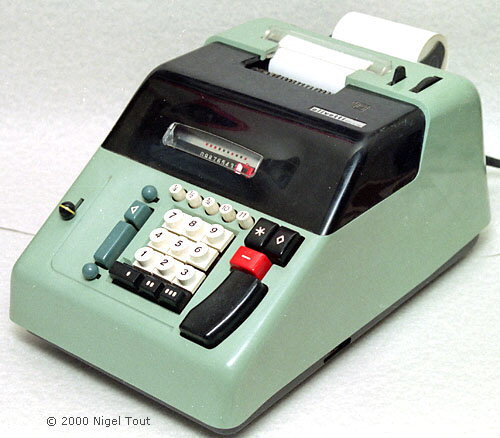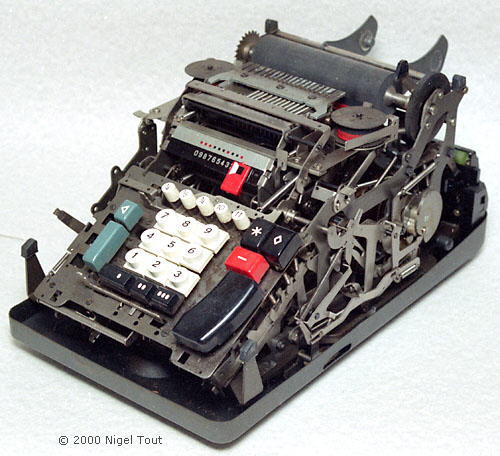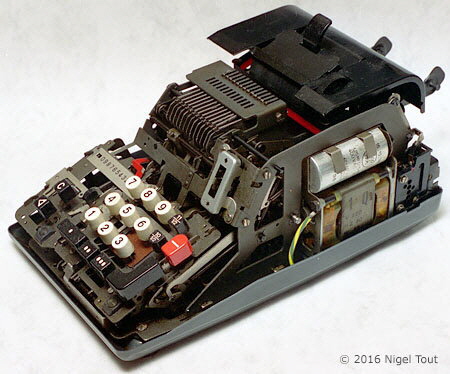Olivetti Elettrosumma 22
and other Olivetti add-listers
From the early 1940s Olivetti of Italy produced a series of compact 'add-listers' (that is primarily for addition and subtraction, and printing a paper list of numbers entered and the results of computations). Here is a selection:
- Ellettrosumma 22
- Elettrosumma 22-R (£sd currency model).
- Quanta 20 (£sd currency model).
- Summa Prima 20

Olivetti Elettrosumma 22
'10-key' add-listing machine.
Electrically powered.
This is an early machine with a metal casing.
The black keys with the white spots enter the same number of zeros as the white spots.
The Elettrosumma 22 was introduced in mid-1958, claiming "With a speed of 210 cycles per minute the Elettrosumma 22 is the fastest adding/listing machine yet produced." It was priced at £89 15s GBP [about US$250].[1]
Grateful thanks to Ville Elomaa for kindly providing the photograph of the Elettrosumma 22.
Ville has also supplied a copy of the Elettrosumma 22 operating manual and a short video of the machine operating with the cover removed.

Olivetti Elettrosumma 22-R
£sd Sterling currency '10-key' add-listing machine (though has extra keys above the standard 10-keys for use with the non-decimal £sd Sterling currency).
Electrically powered.
225 x 380 x 195 mm (9" x 15" x 8").
Made in Italy.
This is a later machine with a plastic casing.
This machine is for use with the British £sd (pre-decimal) currency and has ¼, ½, ¾, 10, and 11 pence keys above the normal 10 keys. The additional complication of the mechanism for a £sd machine must have caused the designers a considerable headache.
The black keys with the
white spots enter the same number of zeros as the white spots.
From Office Magazine, May 64[2] - "Costing £69 15s [GBP (about $195)], the Elettrosumma 22/R has all the chief features of the model 22 but has a reduced capacity of £999,999 19s. 11d. or £99,999 19s. 11¾d. entering, and £9,999,999 19s. 11¾d. totalling. .... ... Its main operational features are: addition and subtraction, with credit balance calculation and signalling; multiplication by rapid repeat addition or subtraction; static memory (an amount can be held on the keyboard through a total or sub-total cycle if required); two-colour printing of all entries and results; non-print control; correcting key; and a simplified 'short' keyboard for easy learning and fast operation for anyone without previous training."

With the covers removed.
Inside is a 3-D maze of mechanical components.
Multiplication (and division) is possible with a "10-key" "add-listing" machine but is not straightforward and requires repeated additions. The article "Sterling Currency (£sd) Multiplication on a 12-key Add-Lister" has instructions for performing multiplication on non-decimal currency amounts with a machine such as the Elettrosumma 22-R and gives an indication of the complexity involved.
One item to note in the above journal description is that the machine has "a simplified 'short' keyboard for easy learning and fast operation for anyone without previous training". This points out that such a "10-key" "add-listing" machine can be operated easily without much training whereas a "full-keyboard" machine such as a Comptometer requires training in how to enter numbers and perform subtraction.

Olivetti Quanta 20 £sd Sterling currency "10-key" add-listing machine (though has extra keys to the right of the standard 10-keys for use with the non-decimal £sd Sterling currency).
Electrically powered.
190 x 340 x 130 mm (7.5" x 13.5" x 5").
Made in Italy.
Introduced in 1965[3].
The Quanta 20 is typical of the small add-listing machines from Olivetti from the 1940s to the early 1970s. Quanta models were still being advertised in 1971 (see advertisement below) when electronic calculators were becoming common. However, it was cheaper than electronic calculators of the period and provided a printed listing which was rare in electronic calculators.

The Olivetti Quanta 20 with the cover removed.


Advertisement for Olivetti Quanta electrically driven mechanical calculators from as late as February 1971 when electronic calculators were becoming common. At around $100, however, it was cheaper than electronic calculators and provided a printed listing.

Olivetti Summa Prima 20 "10-key" add-listing machine.
Hand operated.
240 x 340 x 140 mm (9.5" x 13.5" x 5.5").
Made in Italy.
Introduced in 1961[3].
Cost in 1974: GBP £47.75 (about US$110).
The Summa Prima 20 is typical of the small hand-operated add-listing machines produced by Olivetti from the 1940s to the early 1970s which were very popular since they were fairly cheap and could be used by anyone with a minimal of training.
The control knob at top right on this machine has four positions, away from its neutral centralised position, which produce the operations shown in the diagram on the left.

The Olivetti Summa Prima 20 with the cover removed.

Significance:
Olivetti were great proponents of small, elegant "10-key" mechanical "add-listing" calculators.
Their first adding machine, the "MC 4S Summa" was introduced in 1940, using pressure moulding, followed in 1941 by the "MC 4M Multisumma".
"The story of Olivetti is no less than the story of Italian industrial design. At one time or another every great Italian designer has worked in some capacity for the company... ."
"Mario Bellini (b. 1935) ... has collaborated continuously with Olivetti since 1963, working on their entire product range. Bellini's chief work for Olivetti has been the 'Programma' microcomputer (1965), the 'Logos' and 'Divisumma [18]' calculators (1973), ..."
"One of the greatest of all product designers, Marcello Nizzoli (1887-1969) was the first and most influential of designers to work for Olivetti, ... ... He went on to design a series of machines which have become 'classics' of modern industrial design: ... and the 'Divisumma 24' (1956)."[4]
Further Olivetti mechanical calculators are featured in the Non-Decimal Calculators section and can be found in the Mechanical Calculator section of the Photograph Library.
References:
Mechanical Calculators
Vintage Calculators
Text & photographs copyright, except where stated otherwise, © Nigel Tout 2000-2025.